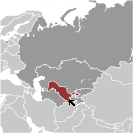World Atlas: Uzbekistan. On this page you can see the map, country flag and many detailed information about the people, history and economy of Uzbekistan.

Here you can find online selected information about the geography, inhabitants, government, economy and history of Uzbekistan. Included are selected statistics, an overview map and the detailed map of Uzbekistan. But let's start with the flag of Uzbekistan here:
Uzbekistan - Overview:
What you should know about Uzbekistan? Let's start with this: Russia conquered the territory of present-day Uzbekistan in the late 19th century. Stiff resistance to the Red Army after the Bolshevik Revolution was eventually suppressed and a socialist republic established in 1924. During the Soviet era, intensive production of "white gold" (cotton) and grain led to overuse of agrochemicals and the depletion of water supplies, which have left the land degraded and the Aral Sea and certain rivers half dry. Independent since 1991 upon the dissolution of the USSR, the country has reduced its dependence on the cotton monoculture by diversifying agricultural production while developing its mineral and petroleum export capacity and increasing its manufacturing base. Uzbekistan’s first president, Islom Karimov, led Uzbekistan for 25 years until his death in September 2016. The political transition to his successor, then-Prime Minister Shavkat Mirziyoyev was peaceful, but sidelined the constitutional process where the chairman of the Senate would have served as the acting president. Mirziyoyev, who won the presidential election in December 2016, has improved relations with Uzbekistan’s neighbors and introduced wide-ranging economic and judicial reforms.
Geography of Uzbekistan
 Where on the globe is Uzbekistan? The location of this country is Central Asia, north of Turkmenistan, south of Kazakhstan. Total area of Uzbekistan is 447,400 sq km, of which 425,400 sq km is land. So this is quite a large country. How could we describe the terrain of the country? This way: mostly flat-to-rolling sandy desert with dunes; broad, flat intensely irrigated river valleys along course of Amu Darya, Syr Darya (Sirdaryo), and Zarafshon; Fergana Valley in east surrounded by mountainous Tajikistan and Kyrgyzstan; shrinking Aral Sea in west. The lowest point of Uzbekistan is Sariqamish Kuli -12 m, the highest point Adelunga Toghi 4,301 m. And the climate is mostly mid-latitude desert, long, hot summers, mild winters; semiarid grassland in east.
Where on the globe is Uzbekistan? The location of this country is Central Asia, north of Turkmenistan, south of Kazakhstan. Total area of Uzbekistan is 447,400 sq km, of which 425,400 sq km is land. So this is quite a large country. How could we describe the terrain of the country? This way: mostly flat-to-rolling sandy desert with dunes; broad, flat intensely irrigated river valleys along course of Amu Darya, Syr Darya (Sirdaryo), and Zarafshon; Fergana Valley in east surrounded by mountainous Tajikistan and Kyrgyzstan; shrinking Aral Sea in west. The lowest point of Uzbekistan is Sariqamish Kuli -12 m, the highest point Adelunga Toghi 4,301 m. And the climate is mostly mid-latitude desert, long, hot summers, mild winters; semiarid grassland in east.
Inhabitants of Uzbekistan
Let's take a look how many people live in Uzbekistan. The number is: 29,748,859 (July 2017 est.). So quite a lot people live here. Who lives here? Uzbek 80%, Russian 5.5%, Tajik 5%, Kazakh 3%, Karakalpak 2.5%, Tatar 1.5%, other 2.5% (1996 est.). What are the languages in Uzbekistan? Uzbek (official) 74.3%, Russian 14.2%, Tajik 4.4%, other 7.1%. And the religions: Muslim 88% (mostly Sunni), Eastern Orthodox 9%, other 3%. How old are the people in average? 28.6 years. We have to add that this number is the median - so one half of the people is older than this, one half is younger. And what is their life expectancy (at birth)? This: 74 years. Where the people live in Uzbekistan? Here: most of the population is concentrated in the fertile Fergana Valley in the easternmost arm of the country; the south has significant clusters of people, while the central and western deserts are sparsely populated. The major urban areas of Uzbekistan are: Tashkent (capital) 2.251 million (2015).
Government and Economy of Uzbekistan
The capital of Uzbekistan is Tashkent (Toshkent) and the government type presidential republic; highly authoritarian. Let's take a look at the administrative divisions - 12 provinces (viloyatlar, singular - viloyat), 1 autonomous republic (avtonom respublikasi), and 1 city (shahar); Andijon Viloyati, Buxoro Viloyati, Farg'ona Viloyati, Jizzax Viloyati, Namangan Viloyati, Navoiy Viloyati, Qashqadaryo Viloyati (Qarshi), Qoraqalpog'iston Respublikasi [Karakalpakstan Republic] (Nukus), Samarqand Viloyati, Sirdaryo Viloyati (Guliston), Surxondaryo Viloyati (Termiz), Toshkent Shahri [Tashkent City], Toshkent Viloyati [Tashkent province], Xorazm Viloyati (Urganch). Regarding the economy of Uzbekistan, important industrial products are textiles, food processing, machine building, metallurgy, mining, hydrocarbon extraction, chemicals. Important agricultural products are cotton, vegetables, fruits, grain; livestock. The most important export commodities are energy products, cotton, gold, mineral fertilizers, ferrous and nonferrous metals, textiles, foodstuffs, machinery, automobiles and the most important export partners are Switzerland 35.1%, China 19.7%, Russia 9.3%, Turkey 8.7%, Kazakhstan 7.2%, Bangladesh 5.4%, Afghanistan 4.9% (2016). The most important import commodities are machinery and equipment, foodstuffs, chemicals, ferrous and nonferrous metals and the most important import partners are China 22.2%, Russia 18%, South Korea 10.5%, Kazakhstan 10%, Turkey 5.8%, Germany 5.2% (2016). How rich is Uzbekistan and how rich are people in this country? The most important number here is GDP per capita (PPP): $7,000 (2017 est.). This is quite a low number. Let's add that this means Gross Domestic Product per person, which is recalculated with respect to the relative cost of local goods and services. And one more important number - population below poverty line: 14% (2016 est.).